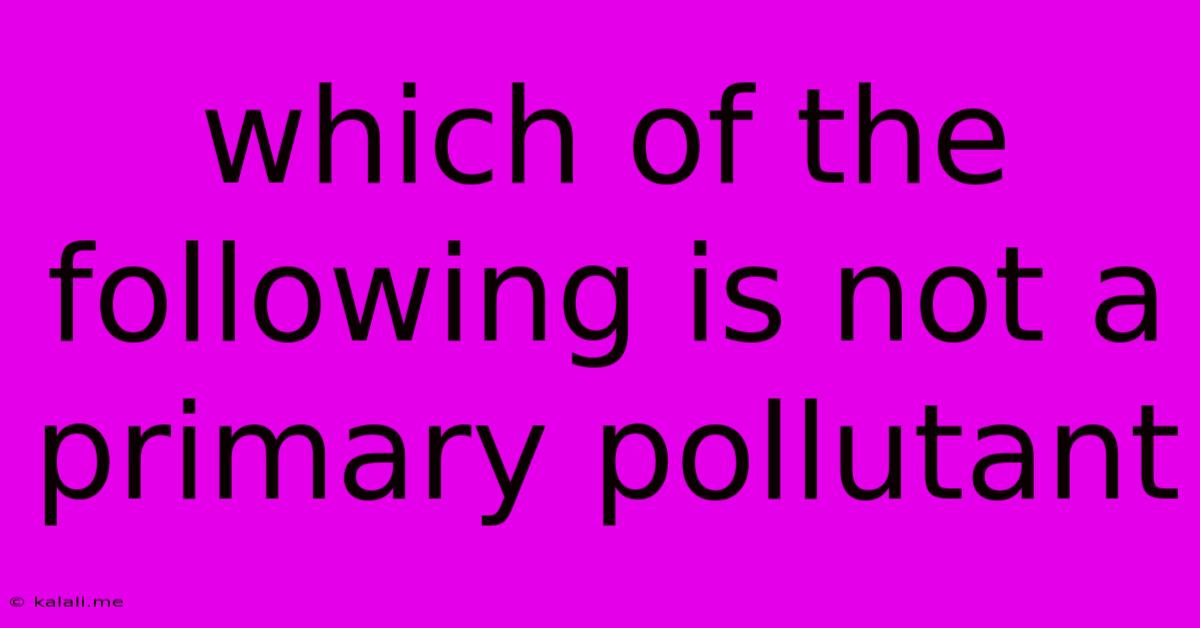Which Of The Following Is Not A Primary Pollutant
Kalali
Jun 13, 2025 · 3 min read

Table of Contents
Which of the Following is NOT a Primary Pollutant? Understanding Air Pollution Sources
Air pollution is a significant environmental concern, impacting human health and the planet's ecosystems. Understanding the different types of pollutants is crucial to addressing this issue effectively. This article will explore primary pollutants and explain why certain substances are classified as secondary pollutants, focusing on identifying which of several options isn't a primary pollutant. We'll also delve into the chemical processes that lead to the formation of secondary pollutants.
What are Primary Pollutants?
Primary pollutants are harmful substances emitted directly into the atmosphere from identifiable sources. These sources can be natural (like volcanic eruptions) or anthropogenic (human-made, such as industrial emissions). Examples of primary pollutants include:
- Carbon monoxide (CO): A colorless, odorless gas produced primarily by incomplete combustion of fossil fuels in vehicles and industrial processes.
- Sulfur dioxide (SO2): A pungent, colorless gas released during the burning of fossil fuels containing sulfur, particularly coal. It contributes significantly to acid rain.
- Nitrogen oxides (NOx): A group of gases, including nitrogen dioxide (NO2), formed during high-temperature combustion processes, such as those in vehicles and power plants.
- Particulate matter (PM): Tiny solid or liquid particles suspended in the air, including dust, soot, and smoke. Sources include vehicle exhaust, industrial emissions, and construction activities.
- Volatile organic compounds (VOCs): Organic chemicals that easily evaporate at room temperature. Many VOCs are released from solvents, paints, and industrial processes.
Secondary Pollutants: The Result of Chemical Reactions
Unlike primary pollutants, secondary pollutants are not directly emitted. They form in the atmosphere through chemical reactions involving primary pollutants and other atmospheric components. Sunlight often plays a crucial role in these reactions, a process known as photochemical smog formation. A key example is:
- Ozone (O3): At ground level, ozone is a harmful secondary pollutant formed through reactions involving NOx and VOCs in the presence of sunlight. It's a major component of smog and contributes to respiratory problems. Note that ozone in the stratosphere plays a beneficial role by absorbing harmful UV radiation.
Identifying the Non-Primary Pollutant
Now, let's address the question: which of the following is NOT a primary pollutant? Without a specific list of options, we can definitively say that ozone (O3) at ground level is not a primary pollutant. As explained above, it's a secondary pollutant formed through atmospheric chemical reactions. Other secondary pollutants include sulfuric acid (H2SO4), nitric acid (HNO3), and various organic nitrates and sulfates.
Understanding the Importance of Differentiating Primary and Secondary Pollutants
Distinguishing between primary and secondary pollutants is crucial for developing effective pollution control strategies. Controlling primary pollutants at their source—through stricter emission standards for vehicles and industries—is vital in reducing the formation of secondary pollutants. This approach is more efficient and cost-effective than trying to remove secondary pollutants after they've formed in the atmosphere.
Conclusion
This exploration of primary and secondary pollutants highlights the complex nature of air pollution. By understanding the sources and formation processes of these pollutants, we can better implement strategies to mitigate their impact on human health and the environment. Remember, ozone, at ground level, is the classic example of a secondary pollutant resulting from the atmospheric transformation of primary pollutants. Focusing on the reduction of primary pollutants is key to tackling the broader problem of air pollution.
Latest Posts
Latest Posts
-
What Is The Lcm Of 4 6 And 9
Jun 14, 2025
-
Which Of The Following Is Not A Reducing Sugar
Jun 14, 2025
-
What Is The Equivalent Capacitance Of The Combination Shown
Jun 14, 2025
-
An Item Is Considered Material If
Jun 14, 2025
-
Genders Are An Example Of Which Type Of Data
Jun 14, 2025
Related Post
Thank you for visiting our website which covers about Which Of The Following Is Not A Primary Pollutant . We hope the information provided has been useful to you. Feel free to contact us if you have any questions or need further assistance. See you next time and don't miss to bookmark.